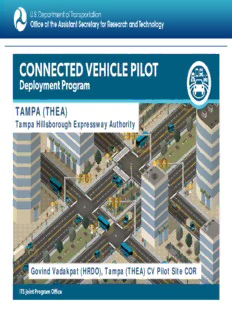
tampa (thea) PDF
Preview tampa (thea)
TAMPA (THEA) Tampa Hillsborough Expressway Authority Govind Vadakpat (HRDO), Tampa (THEA) CV Pilot Site COR O VERVIEW Connected Vehicles Pilot Deployment Program Overview Goals □ Organizing Principles □ CV Applications □ Program Schedule and Future Milestones □ CV Pilots Wave 1 Sites: □ ▪ ICF/Wyoming, New York City, Tampa (THEA) Tampa Hillsborough Expressway Authority (THEA) CV Pilot Deployment Overview Pilot Objective □ Pilot Deployment Site: Target Areas □ Pilot Site Needs, CV Applications and Performance Measures □ Pilot Deployment Vision □ Timeline and Phase 1 Deliverable Schedule □ How to Stay Connected U.S. Department of Transportation 2 CV P D P W ILOT EPLOYMENT ROGRAM ITHIN T USDOT ITS S P HE TRATEGIC LAN The Connected Vehicle (CV) Pilot USDOT ITS Strategic Plan, pg. 14 Deployment Program Keystone effort in connected vehicle □ area Also plays a key role in other strategic □ areas, including accelerating deployment, promoting interoperability, and enterprise data CV Pilot Deployments offer a unique opportunity related to getting CV technology to the field and making a difference in many areas, including: Needs-driven planning and investment □ Integrated performance measurement □ Lowering barriers to deployment □ http://ntl.bts.gov/lib/54000/54400/54481/Strat_Plan_Final_Version.pdf U.S. Department of Transportation 3 CV P D P G ILOT EPLOYMENT ROGRAM OALS U.S. Department of Transportation 4 CV P O P ILOT RGANIZING RINCIPLES CV Pilots are pilot deployments, that is, real-world environment deployments The successful, deployed technologies are expected to remain as permanent □ operational elements Deployment concepts are needs-driven Each site has different needs, focus and applications □ ▪ That is, each pilot deployment will address critical problem(s) ▪ The needs of each site will drive the deployment process Pilot deployments are expected to be both large-scale with multiple applications Large-scale implies pilot deployments will have measureable impact, not a specific □ minimum geographic or vehicle fleet size Sites will deploy multiple applications drawing on the products of USDOT and □ other connected vehicle research U.S. Department of Transportation 5 CV P D R ILOT EPLOYMENT EQUIREMENTS Multiple connected vehicle applications must be deployed together Pilot deployments should leverage USDOT-sponsored research Pilot deployments include the capture of data from multiple sources Integrated or carry-in devices for connected vehicles capable of generating an SAE □ J2735 Basic Safety Message (BSM) Share pilot deployment data while protecting privacy and intellectual property □ Multiple forms of communications technologies are desired Dedicated Short Range Communications (DSRC) 5.9 GHz utilized as one □ communication technology Well-defined, focused, quantitative performance measures Support an independent evaluation effort □ Security and credentialing management system U.S. Department of Transportation 6 C V A ONNECTED EHICLE PPLICATIONS The USDOT has made a significant investment in foundational research and initial development of 50+ connected vehicle applications Concepts of Operations □ System Requirements □ Prototype Design and Testing □ Prototype Impacts Assessment □ Analytics, Modeling and Simulation to Assess Potential Long-Term Impacts □ Not all CV Application efforts are in the same state of maturity, few are complete But a large number of application development efforts across multiple programs □ have been completed GOAL: move deployment-ready application concepts forward into integrated □ deployments addressing key performance concerns U.S. Department of Transportation 7 C V A ONNECTED EHICLE PPLICATIONS V2I Safety Environment • Red Light Violation Warning • Eco-Approach and Departure at Signalized • Curve Speed Warning Intersections • Stop Sign Gap Assist • Eco-Traffic Signal Timing • Spot Weather Impact Warning • Eco-Traffic Signal Priority • Reduced Speed/Work Zone Warning • Connected Eco-Driving • Pedestrian in Signalized Crosswalk Warning • Wireless Inductive/Resonance Charging (Transit) • Eco-Lanes Management • Eco-Speed Harmonization V2V Safety • Eco-Cooperative Adaptive Cruise Control • Eco-Traveler Information • Emergency Electronic Brake Lights (EEBL) • Forward Collision Warning (FCW) • Eco-Ramp Metering • Intersection Movement Assist (IMA) • Low Emissions Zone Management • Left Turn Assist (LTA) • AFV Charging / Fueling Information • Blind Spot/Lane Change Warning (BSW/LCW) • Eco-Smart Parking • Do Not Pass Warning (DNPW) • Dynamic Eco-Routing (light vehicle, transit, freight) • Vehicle Turning Right in Front of Bus Warning • Eco-ICM Decision Support System (Transit) U.S. Department of Transportation 8 C V A ONNECTED EHICLE PPLICATIONS (C ) ONTINUED Mobility Road Weather • Advanced Traveler Information System • Motorist Advisories and Warnings (MAW) • Intelligent Traffic Signal System • Enhanced MDSS • (I-SIG) • Vehicle Data Translator (VDT) • Signal Priority (transit, freight) • Weather Response Traffic Information (WxTINFO) • Mobile Accessible Pedestrian Signal System (PED-SIG) • Emergency Vehicle Preemption (PREEMPT) Smart Roadside • Dynamic Speed Harmonization (SPD-HARM) • Wireless Inspection • Queue Warning (Q-WARN) • Smart Truck Parking • Cooperative Adaptive Cruise Control (CACC) • Incident Scene Pre-Arrival Staging Guidance for Emergency Responders (RESP-STG) Agency Data • Incident Scene Work Zone Alerts for Drivers and Workers (INC-ZONE) • Probe-based Pavement Maintenance • Emergency Communications and Evacuation • Probe-enabled Traffic Monitoring (EVAC) • Vehicle Classification-based Traffic Studies • Connection Protection (T-CONNECT) • CV-enabled Turning Movement & Intersection • Dynamic Transit Operations (T-DISP) Analysis • Dynamic Ridesharing (D-RIDE) • CV-enabled Origin-Destination Studies • Freight-Specific Dynamic Travel Planning and Performance • Work Zone Traveler Information • Drayage Optimization U.S. Department of Transportation 9 CV P D P S : ILOT EPLOYMENT ROGRAM CHEDULE W 1 (P 1-3) AVE HASES In Progress Follow-On Cooperative Agreement Phase 1: Concept Development (Current Phase) Creates the foundational plan to enable further design and deployment □ □ Progress Gate: Is the concept ready for deployment? Phase 2: Design/Deploy/Test Detailed design and deployment followed by testing to ensure deployment functions as □ intended (both technically and institutionally) Progress Gate: Does the system function as planned? □ Phase 3: Maintain/Operate Focus is on assessing the performance of the deployed system □ Post Pilot Operations (CV tech integrated into operational practice) U.S. Department of Transportation 10
Description: